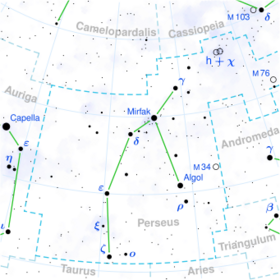Astronomy:34 Persei
| Observation data Equinox J2000.0]] (ICRS) | |
|---|---|
| Constellation | Perseus |
| Right ascension | 03h 29m 22.05019s[1] |
| Declination | 49° 30′ 32.2114″[1] |
| Apparent magnitude (V) | 4.67[2] (4.76 + 7.18)[3] |
| Characteristics | |
| Spectral type | B3V[4] |
| U−B color index | −0.57[5] |
| B−V color index | −0.09[5] |
| Astrometry | |
| Radial velocity (Rv) | −3.50[6] km/s |
| Proper motion (μ) | RA: +22.20[1] mas/yr Dec.: −29.49[1] mas/yr |
| Parallax (π) | 6.05 ± 0.36[1] mas |
| Distance | 540 ± 30 ly (165 ± 10 pc) |
| Absolute magnitude (MV) | −1.62[2] |
| Details | |
| 32 Per A | |
| Mass | 6.9±0.1[7] M☉ |
| Radius | 3.1[8] R☉ |
| Luminosity | 671[2] L☉ |
| Surface gravity (log g) | 4.076[9] cgs |
| Temperature | 16,421[9] K |
| Rotational velocity (v sin i) | 200[9] km/s |
| Age | 29.3±3.4[7] Myr |
| Other designations | |
| Database references | |
| SIMBAD | data |
34 Persei is a binary star[3] system in the northern constellation of Perseus. It is visible to the naked eye as a faint, blue-white hued point of light with a combined apparent visual magnitude of 4.67.[2] The system is located approximately 540 light years away from the Sun based on parallax,[1] but it is drifting closer with a radial velocity of −3.5 km/s.[6] It is a likely member of the Alpha Persei Cluster.[11]
The primary member, designated component A, is a B-type main-sequence star with a stellar classification of B3V[4] and visual magnitude 4.76.[3] It is an estimated 29[7] million years old with a high rate of spin, showing a projected rotational velocity of 200 km/s.[9] The star has 6.9[7] times the mass of the Sun and about 3.1[8] times the Sun's radius. It is radiating 671[2] times the Sun's luminosity from its photosphere at an effective temperature of 16,421 K.[9]
The secondary companion, component B, has an angular separation of 0.6″ from the primary and visual magnitude of 7.34.[12]
References
- ↑ 1.0 1.1 1.2 1.3 1.4 1.5 Van Leeuwen, F. (2007). "Validation of the new Hipparcos reduction". Astronomy and Astrophysics 474 (2): 653–664. doi:10.1051/0004-6361:20078357. Bibcode: 2007A&A...474..653V. Vizier catalog entry
- ↑ 2.0 2.1 2.2 2.3 2.4 Anderson, E.; Francis, Ch. (2012). "XHIP: An extended hipparcos compilation". Astronomy Letters 38 (5): 331. doi:10.1134/S1063773712050015. Bibcode: 2012AstL...38..331A. Vizier catalog entry
- ↑ 3.0 3.1 3.2 Eggleton, P. P.; Tokovinin, A. A. (September 2008). "A catalogue of multiplicity among bright stellar systems". Monthly Notices of the Royal Astronomical Society 389 (2): 869–879. doi:10.1111/j.1365-2966.2008.13596.x. Bibcode: 2008MNRAS.389..869E.
- ↑ 4.0 4.1 Hoffleit, D.; Warren, W. H. (1995). "Bright Star Catalogue". VizieR On-line Data Catalog: V/50. Originally Published in: 1964BS....C......0H 5050. Bibcode: 1995yCat.5050....0H.
- ↑ 5.0 5.1 Mallama, A. (2014). "Sloan Magnitudes for the Brightest Stars". The Journal of the American Association of Variable Star Observers 42 (2): 443. Bibcode: 2014JAVSO..42..443M.Vizier catalog entry
- ↑ 6.0 6.1 Gontcharov, G. A. (2006). "Pulkovo Compilation of Radial Velocities for 35 495 Hipparcos stars in a common system". Astronomy Letters 32 (11): 759–771. doi:10.1134/S1063773706110065. Bibcode: 2006AstL...32..759G.
- ↑ 7.0 7.1 7.2 7.3 Tetzlaff, N. et al. (January 2011). "A catalogue of young runaway Hipparcos stars within 3 kpc from the Sun". Monthly Notices of the Royal Astronomical Society 410 (1): 190–200. doi:10.1111/j.1365-2966.2010.17434.x. Bibcode: 2011MNRAS.410..190T.
- ↑ 8.0 8.1 Pasinetti Fracassini, L. E. et al. (February 2001), "Catalogue of Apparent Diameters and Absolute Radii of Stars (CADARS)", Astronomy and Astrophysics 367 (2): 521–524, doi:10.1051/0004-6361:20000451, Bibcode: 2001A&A...367..521P
- ↑ 9.0 9.1 9.2 9.3 9.4 David, Trevor J.; Hillenbrand, Lynne A. (2015). "The Ages of Early-Type Stars: Strömgren Photometric Methods Calibrated, Validated, Tested, and Applied to Hosts and Prospective Hosts of Directly Imaged Exoplanets". The Astrophysical Journal 804 (2): 146. doi:10.1088/0004-637X/804/2/146. Bibcode: 2015ApJ...804..146D.
- ↑ "34 Per". SIMBAD. Centre de données astronomiques de Strasbourg. http://simbad.u-strasbg.fr/simbad/sim-basic?Ident=34+Per.
- ↑ Zuckerman, B. et al. (June 2012). "Stellar Membership and Dusty Debris Disks in the α Persei Cluster". The Astrophysical Journal 752 (1): 12. doi:10.1088/0004-637X/752/1/58. 58. Bibcode: 2012ApJ...752...58Z.
- ↑ Mason, Brian D. et al. (2001). "The 2001 US Naval Observatory Double Star CD-ROM. I. The Washington Double Star Catalog". The Astronomical Journal 122 (6): 3466. doi:10.1086/323920. Bibcode: 2001AJ....122.3466M. Vizier catalog entry
 |

